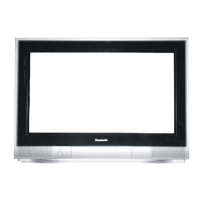
Do you have a question about the Panasonic QUINTRIX TX-86PW300A and is the answer not in the manual?
| Display Technology | CRT |
|---|---|
| Audio Output | 20 W |
| Sound System | Nicam Stereo |
| TV Standard | PAL |
| Display Type | Flat Screen |
| Input Ports | Component Video, Composite Video, S-Video, SCART |
Details on recycling cardboard and plastics, and Panasonic's environmental commitment.
Critical warnings about TV weight, placement, and electrical safety.
Explanation of the Owner ID feature for security and ownership proof.
Information on magnetic interference and demagnetisation.
Instructions for connecting the television aerial.
Instructions for connecting the power plug and turning on the TV.
Steps for opening, inserting, and closing the battery cover.
Warnings and precautions regarding battery handling and use.
Identifies and describes buttons on the TV's front panel.
Identifies and describes all buttons on the remote control.
Function for storing tuning information and settings.
Selects on-screen display functions and adjusts settings.
Buttons for selecting programme numbers and adjusting settings.
Switches between TV and AV input modes.
Explains STANDBY, PICTURE, SOUND, and SET UP buttons.
Explains STEREO/MONO, 100Hz/PROGRE, SURROUND, and ASPECT buttons.
Details the MULTI PIP function for viewing multiple images.
Explains how to use Picture-in-Picture, Picture-Out-of-Picture, and Picture-and-Picture.
Explains RECALL for viewing settings and NORMALISATION for resetting.
How the STR button is used for storing settings and Teletext.
Explains the HELP button and SOUND MUTE function.
Controls for adjusting volume and changing channels.
Using TV/AV for input switching and STILL for freezing images.
Explains the use of coloured buttons for various functions.
How to use the CH SEARCH button to preview channels.
How to directly select single and two-digit programme numbers.
How to access and navigate the main menus on screen.
Using the HELP button and accessing menu demonstrations.
Explains Dynamic, Normal, and Cinema viewing modes.
Adjusting Contrast, Brightness, Colour, Sharpness, and Colour Temperature.
Settings for P-NR and Scan mode for picture quality.
Resets all picture settings to factory defaults.
Explains sound modes (Music, News, Cinema) and volume adjustments.
Adjusting Bass, Treble, and Balance for sound output.
Adjusting volume for headphones and the subwoofer.
Explains the Virtual Dolby Surround System for enhanced audio.
Controls Teletext modes (TOP, FASTEXT, List).
Setting automatic power-off and power-on timers.
Adjusting channel colour density and enabling child lock.
Features for signal loss and interference reduction.
Motion compensation and magnetic interference adjustment.
Security feature and VCR/Game signal enhancement.
Choosing the correct colour system for AV signals.
Explains causes of interference and picture distortion.
Steps to adjust geomagnetic correction using the TV's controls.
Steps to adjust geomagnetic correction using the remote.
Tips for resolving colour patches and tilt from interference.
Step-by-step guide to inputting PIN, name, and address.
How the Auto mode selects the best aspect ratio.
Explains 16:9 and 4:3 aspect modes for standard viewing.
Explains Zoom, JUST, and 21:9 modes for filling the screen.
Explains TOP and FASTEXT modes for Teletext navigation.
Explains how to use and navigate Teletext in List mode.
How to store and recall favourite Teletext pages.
Switching between TV and Teletext, and navigating pages.
Using INDEX to return to main page and HOLD to freeze content.
Using coloured buttons for Teletext and STR for storage.
Directly entering specific Teletext page numbers.
Using the REVEAL function for concealed Teletext content.
Adjusting screen display and cancelling Teletext transmission.
Entering sub-page numbers when waiting for content.
Switching the television system between regions.
Steps to reach the tuning menu using the TV's controls.
Steps to reach the tuning menu using the remote.
Guide to initiating an automatic channel scan via front panel.
Guide to initiating an automatic channel scan via remote.
Steps for manually tuning individual channels via front panel.
Steps for manually tuning individual channels via remote.
Instructions for tuning the TV to receive signals from a VCR.
Adjusting reception for optimal picture quality using front panel.
Adjusting reception for optimal picture quality using remote.
How to revert or cancel fine tuning adjustments.
Bypassing unwanted channels using the front panel.
Bypassing unwanted channels using the remote control.
Functions for REWIND, STOP, RECORD, PAUSE, PLAY, FAST FORWARD.
Using POWER BUTTON and VCR/DVD switch.
Controlling channel numbers and skipping tracks.
Programming the remote for specific VCR/DVD brands using codes.
Connecting headphones and adjusting their volume.
Connecting VCRs, cameras, and games via front AV inputs.
Connecting DVD players and set-top boxes to AV1/AV4 inputs.
Connecting S-Video devices using Mini Din plugs.
Connecting standard VCRs to AV inputs for optimal quality.
Connecting Monitor Out to other TVs or audio systems.
Warnings about inserting objects, high voltage, and power cord safety.
Advice on ventilation, liquids, location, and physical shocks.
Tips for unusual operation, moving the TV, and aerial installation.
Safe methods for cleaning the TV screen and cabinet.
Instructions for keeping the remote control lens clean.
Recording purchase details for warranty and identification.
Common user questions and their solutions for TV operation.
Checks for Snowy Picture, Multiple Image, Interference, No Colour.
Checks for Noisy Sound, Normal Sound, No Sound issues.
Advice for No Picture, No Colour, Scrambled, Colour Patches, Rolling Picture.
Lists all available video/audio terminals and input specifications.
Details tuning systems, power, picture tube, audio, and Teletext specifications.
Lists included accessories and provides physical dimensions and weight.
Details Panasonic's warranty conditions for products sold in Australia.
Details Panasonic's warranty conditions for products sold in New Zealand.
